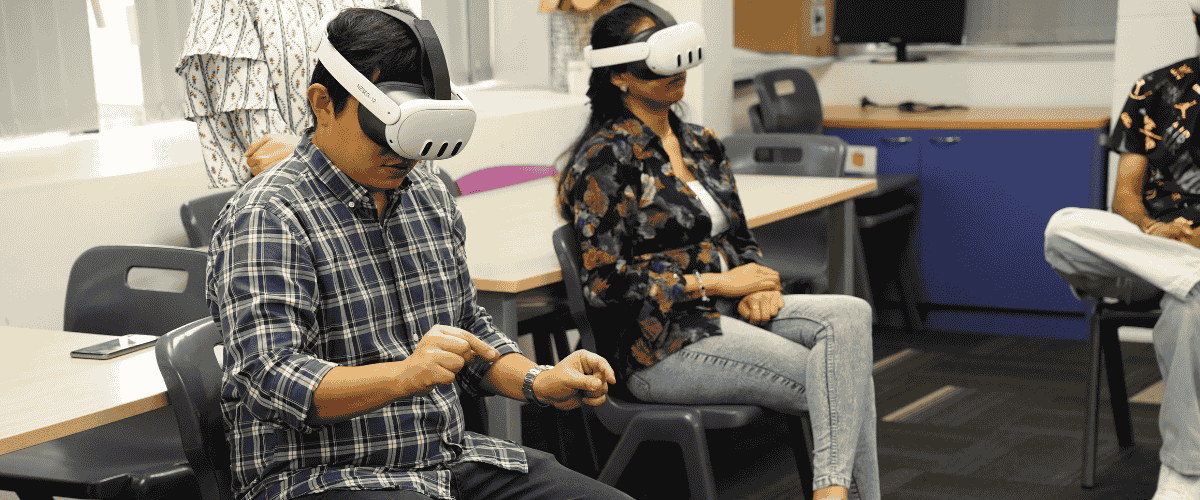When virtual reality first came to NZSE College’s campus, NZSEG CEO Wendy Liao was the first to trial it. Lost in the immersive world — a hospital room and sick client — Liao reverted to speaking to “Mr Anderson” in her mother tongue of Mandarin Chinese. Before anyone could interrupt to tell Liao that he only speaks English, the Samoan patient responded in fluent Mandarin. Infinitely intelligent, Mr Anderson is powered with ChatGPT. Watch the video below to see him in action.
Months earlier, the Group Academic Director of NZSE, Dr Neel Pandey, made contact with a creative technology studio called Waxeye to enquire about the use of immersive technology in the classroom. As an engineer and tech enthusiast, Dr Pandey had a vision for a cutting-edge curriculum. “I had this idea in my mind of using technology to create a simulated environment which closely resembles the actual workforce — in this case, a hospital for our future healthcare workers at NZSE,” says Dr Pandey.
Waxeye’s Director of XR Innovation Neil Patton and his team set about the task. Initially, Patton and Dr Pandey discussed 360° footage, but it became apparent quickly that there was a better solution for the breadth of information at hand: virtual reality.
“We created a three dimensional avatar for students to interact with. Just like when you write a book, we created a backstory for Mr Anderson. He has a diagnosis and the prognosis isn’t good. His wife has passed away, he was a school teacher in Timaru, he is Samoan. He has a life story. There is all this colour to him, and when you start talking with him, parts of that will be revealed,” says Patton.
Mr Anderson is prickly on the surface, but he is programmed to respond in kind — if you find ways to connect with him, he becomes more open to your service. This is a key soft skill for healthcare workers, and NZSE’s health experts Dr Sadia Faisal, Paulina Fuentes, Priyanka Thakur, and Tim Salera crafted the programme with Waxeye to encourage students to build rapport.
“Aged care is a time of transition. And often it’s about coming to terms with one’s mortality. So we decided to create a client who is new to aged care, who is undergoing the loss of independence, and perhaps, even dealing with grief,” says Tim Salera, Health and Wellbeing Tutor.
Salera and the health team also wanted Mr Anderson to be Pasifika, to not only capture a prevalent population that goes through the health system, but to also highlight the Fonofale model of care — a holistic, Pacific health framework. With a majority percentage of international health students, NZSE makes a conscious effort to weave cultural competency into the curriculum.
The virtual reality programme is broken up into modules that also reinforce compassion, active listening, and professionalism. “Most of our students are new to the field and don’t have a firm grasp on the concepts of privacy, confidentiality, and informed consent,” says Salera. The joy of the virtual reality programme is that learners can afford to make mistakes in real time, with no consequences or harm done.
NZSE student Tanya Hodgkinson is acutely aware of the gravity that a healthcare role brings. “There is a lot of pressure on workers to get it right. We deal with serious issues and consequences. We deal with people from all cultures and belief systems… but VR allows you to play with certain angles and learn in a comfortable environment. It takes the risk element right out,” says Hodgkinson.
Without this fear, Hodgkinson has fun employing different tactics to coax Mr Anderson out of his shell — “Do you want a fruit platter?” It is all light-hearted, until Mr Anderson starts to challenge his own belief system. “He pretty much hit a low point where he said to me, ‘I don’t know if I can go on’,” says Hodgkinson.
The surrealness of the programming even astounds the creator himself. “You have got someone who has been religious all their life, and now they are facing death, so questions arise. The avatar, Mr Anderson, has so much depth. I would talk to him one week, and then come back and talk to him again at a later date, and he would remember our conversation and reference it — reference my family and my stories that I had shared,” says Patton.
It makes practice as close to reality as possible. Unlike traditional classroom teaching, it simulates challenging conversations, which otherwise feel unnatural or intimidating during roleplay with a teacher or fellow student. The feedback from NZSE learners has been incredible, with the VR described as fascinating, enriching, and insightful; embedding the importance of trust and other concepts that they previously took for granted.
Often we hear stories about the challenges of AI for the education sector, but perhaps it is not the disruptive force that we feared it to be. Patton says that VR is an impactful way of demonstrating a student’s understanding, because they “can’t just use a large language model to finish that essay. They actually have to show that they understand the skills and practice it with the AI avatar.”
